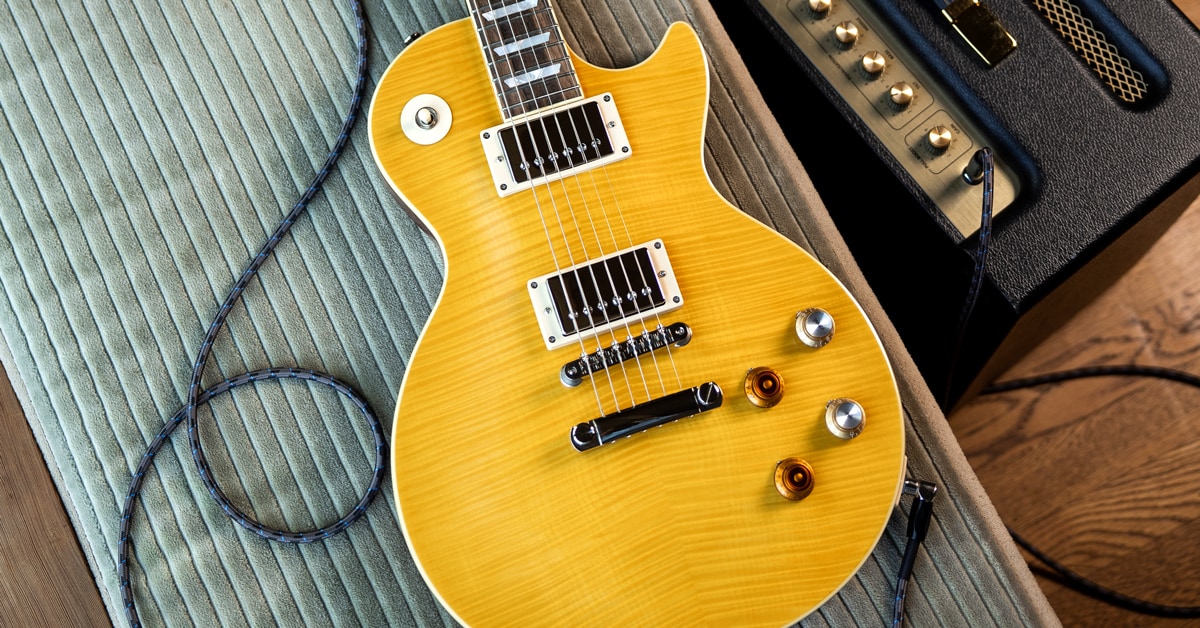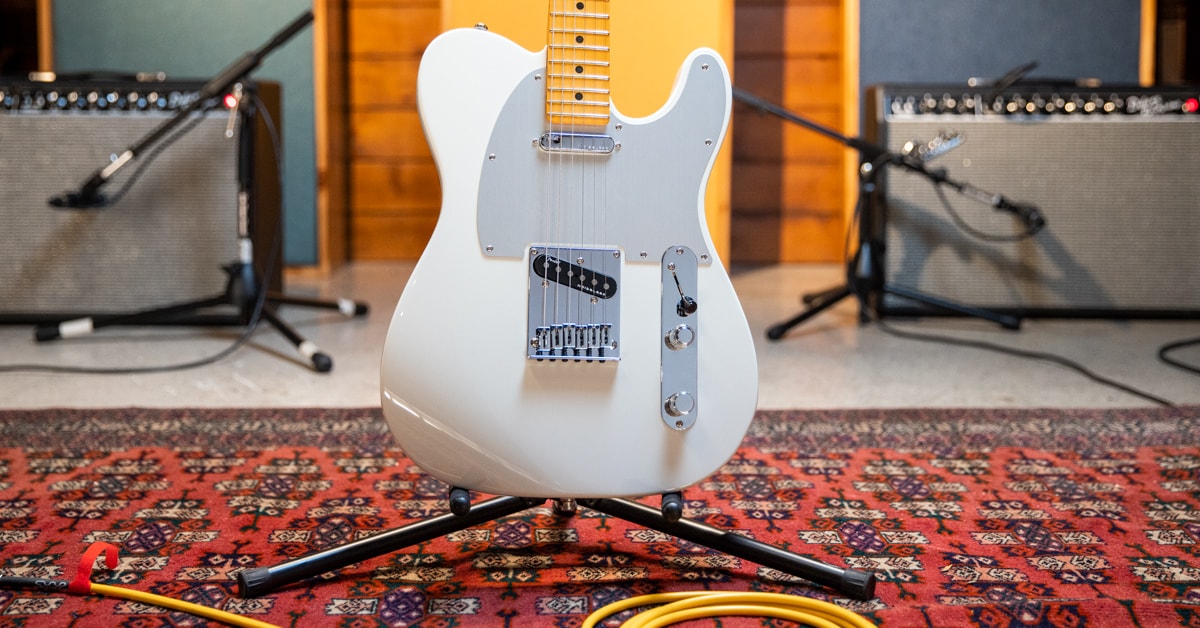Introduced in 2019, the prime mission of the Fender American Ultra series is to continually generate innovation—and modernization—of the company’s iconic instruments. American Ultra guitars and basses are also crafted to inspire committed performers who are constantly gigging, recording and composing.
The next evolution is the Fender American Ultra II series, which advances tone and playability with Fender Ultra Noiseless Gen II single-coils and Haymaker humbuckers, quartersawn necks, Luminlay side dots, new colors and more. While the new lineup includes the usual suspects—Stratocasters (including a lefty model), Telecasters and Precision and Jazz Basses (plus a Jazz Bass V)—it also adds the stunningly space-age Meteora guitar and Meteora bass.
To provide some conceptual context for the American Ultra II refinements, we talked to Fender Vice President of Product (Electric Guitars and Amplifiers) Joey Brasler, who provides behind-the-scenes insights on the company’s modification process and design decisions.
Pictured: Tim Stewart playing the Fender American Ultra II Meteora
When you strategize upgrading a series to its next level, what are the foremost goals?
When we begin to spec a new series—whether it’s brand new or a revision of an existing series—we start with identifying the customer. Who buys American Ultra today? What music do they play? What sounds are they looking for? What’s most important to them?
We start creating a new series two years before it launches, so we can see if there are technologies that weren’t available, say, four years ago. Can we make the instruments smoother, faster, more responsive and better sounding? Can we give the Ultra player sweeter pickups, upgraded hardware and better necks? How can we advance the playability and tone to make it a better instrument? And, of course, we’re always working on new finishes.
Can you share how decisions regarding model shifts are made when a series such as Ultra moves to Ultra II? For example, Luxe models were not invited to the Ultra II team, the Jazzmaster and Stratocaster Limited Edition were dropped, and the Meteora models joined the crew.
Model swaps are common for Fender when we refresh a series, because we want to inject excitement into the line to capture the imaginations of players. Also, we have far too many models to put them all in a series at one time. When we’re dreaming up the new line, we get excited wondering what we’d do with, for instance, a Meteora and a Meteora Bass in Ultra II. You’ll always see model swaps in new series. Ultra Luxe is its own limited collection, and you’ll see a new Ultra Luxe series in the future.
Pictured: Jonny Goood playing the Fender American Ultra II Jazz Bass
What informed the design decision to add or drop colors for American Ultra II, and what inspired the new colors?
The search never stops—we’re always looking for new colors. Ultra I had a mix of sports car colors, as well as finishes we dreamed up, such as Mocha Burst and Texas Tea. For Ultra II, we mixed modern supercars with a couple of industrial colors we’ve been wanting to use for a while. They’re bolder, flashier finishes that pair nicely with the modern aesthetic of the series.
How were the Ultra Noiseless Gen II single-coils voiced, and in what ways does the sound differ from Ultra Noiseless single-coils?
Our goal from the start was to make Ultra II Noiseless pickups sound and feel even more like our favorite single-coil pickups—achieving that beautiful Fender top-end character and chime, while also keeping the noise floor as low as possible. We’re thrilled with the Ultra II Vintage and Hot sets. The bass pickups are all new, as well, and are paired with a new active preamp
Likewise, what are the specific sonic differences between the Ultra II Haymaker humbuckers and the Ultra Double Tap humbuckers included on the Ultra series HSS models?
The Double Tap pickup on the original Ultra Strat is a spectacular lower-output design that un-taps a hotter single-coil when you split the humbucker. The hotter single-coil drives your amp and mates with the middle pickup for a perfect position 2 sound. The Double Tap humbucker is still available separately from Fender.
The Ultra II Haymaker is a straight humbucking design—fat and soaring, yet well-defined—that splits into a hot single-coil that’s a perfect match for the bridge-and-middle pickup recipe.
Pictured: Mason Stoops playing the Fender American Ultra II Telecaster
Quartersawn necks are new to the Ultra II series. What was the thinking behind that upgrade?
Quartersawn necks are produced by using a non-standard method of milling lumber. They’re stronger, stiffer and less susceptible to wear, twisting or warping than flat sawn necks. You can feel the difference when you play them. Quartersawn necks are also more expensive, and they are a superior choice that belongs on the American Ultra II series.
The Ultra II series also features Luminlay side dots. Anyone who performs on dark stages will appreciate those, of course, but what prompted their inclusion at this time?
We’ve heard stories from our artists about standing off stage in pitch black, and then running onstage blinded by bright lights. In both cases, they had issues finding their way until they were able to adjust to the light. Luminlay side dots are a great solution for pros performing on any stage.
Pictured: Ari O'Neal Playing the Fender American Ultra II HSS Stratocaster
Were there ideal “test rigs” for each model in the American Ultra II series as you developed enhancements and upgrades?
It was a mix of our favorite old amps, new amps and other things in process at the time—such as Tone Master Pro, the new Tone Master ’59 Bassman, the new Champion II amp line, the Mustang Micro and new pedals. We tested American Ultra II through every amp, pedal and modeler we could get our hands on.
As legacy models evolve through the years, do you have a priority list regarding which features you feel players want? Is enhanced playability more desired than more versatile tones? Are new colors a big draw?
It all matters. Playability, pickups and tone, new finishes and new tech, and bridges, nuts, tremolos and electronics. It’s all part of creating a new series aimed at thrilling players.
When tracking the changing needs of guitarists and bassists, what factors typically prompt the Fender team to say, “Okay, now we need to upgrade the series to meet the requirements of today’s players”?
It’s a process that starts literally on day one of a new series launch. Once the new product is out in the world, we study all of the feedback from players and customers on internet forums, social media and so on. These comments start informing future changes—things they wish it had, things they’d change if they could, new models, new colors, etc. In concert with in-person feedback from artists, we start to tally new ideas for the next iteration of the series almost immediately—even if just informally. It really is a never-ending process of learning, asking questions and keeping an open mind.








